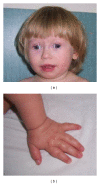Ophthalmic treatment and vision care of a patient with rare ring chromosome 15: a case report
- PMID: 24991444
- PMCID: PMC4065758
- DOI: 10.1155/2014/285132
Ophthalmic treatment and vision care of a patient with rare ring chromosome 15: a case report
Abstract
The Aim. Ring chromosome 15 is a very rare genetic abnormality with a wide spectrum of clinical findings. Up to date, about 50 cases have been documented, whereas no reports on ophthalmological treatment of such patients have been published. The aim of this study is not only to describe a new patient, but also, for the first time, to present the results of nonoperative management of divergent strabismus. Material and Methods. We present an amblyopic patient with 46,XX, r(15) karyotype: treated conservatively for exotropia of 60 prism diopters. The management consisted of refractive and prismatic correction, eye occlusion, and orthoptic exercises between the age of 15 months and 8 years. Results. The deviation angle of exotropia was decreased to 10 prism diopters, the visual acuity improved to 1.0 in both eyes (Snellen chart) and the fixation pattern was normal. The prisms enabled permanent symmetrical stimulation of the retina, which lead to a development of normal single binocular vision (Maddox test, filter test, and synoptophore tests). Conclusions. Parental karyotype was normal; the analysis of a three-generation pedigree has shown no genetic abnormalities or pregnancy losses so the child's karyotype anomaly was classified as de novo that is a single occurrence of this type of chromosomal disorder in this family. Strabismus in ring chromosome 15 patients is a difficult condition to manage, although success may be achieved.
Figures
Similar articles
-
Management of strabismus in nanophthalmic patients: a long-term follow-up report.Ophthalmology. 2003 Jun;110(6):1230-6. doi: 10.1016/S0161-6420(03)00267-7. Ophthalmology. 2003. PMID: 12799252
-
Intrastromal corneal ring implants for corneal thinning disorders: an evidence-based analysis.Ont Health Technol Assess Ser. 2009;9(1):1-90. Epub 2009 Apr 1. Ont Health Technol Assess Ser. 2009. PMID: 23074513 Free PMC article.
-
Prism treatment of acute acquired concomitant esotropia precipitated by visual confusion.Strabismus. 2020 Mar;28(1):7-12. doi: 10.1080/09273972.2020.1717552. Strabismus. 2020. PMID: 32301677
-
[Non-surgical treatment of convergent strabismus with a localization method].Klin Oczna. 1994 Oct-Nov;96(10-11):324-8. Klin Oczna. 1994. PMID: 7715150 Polish.
-
Double vision in adults.J Binocul Vis Ocul Motil. 2018 Jul-Sep;68(3):63-69. doi: 10.1080/2576117X.2018.1481265. Epub 2018 Jun 21. J Binocul Vis Ocul Motil. 2018. PMID: 30196786
Cited by
-
Ring chromosome 15 - cytogenetics and mapping arrays: a case report and review of the literature.J Med Case Rep. 2018 Nov 16;12(1):340. doi: 10.1186/s13256-018-1879-5. J Med Case Rep. 2018. PMID: 30442194 Free PMC article. Review.
-
The phenotype and rhGH treatment response of ring Chromosome 15 Syndrome: Case report and literature review.Mol Genet Genomic Med. 2021 Dec;9(12):e1842. doi: 10.1002/mgg3.1842. Epub 2021 Nov 8. Mol Genet Genomic Med. 2021. PMID: 34747577 Free PMC article. Review.
References
-
- Jacobsen P. A ring chromosome in the 13–15 group associated with microcephalic dwarfism, mental retardation and emotional immaturity. Herediatias. 1966;55:188–191.
-
- Glass IA, Rauen KA, Chen E, et al. Ring chromosome 15: characterization by array CGH. Human Genetics. 2006;118(5):611–617. - PubMed
-
- Liu Y-H, Chang SD, Chen F-P. Increased fetal nuchal fold leading to prenatal diagnosis of ring chromosome 15. Prenatal Diagnosis. 2001;21(12):1031–1033. - PubMed
-
- Hatem E, Meriam BR, Walid D, Adenen M, Moez G, Ali S. Molecular characterization of a ring chromosome 15 in a fetus with intra uterine growth retardation and diaphragmatic hernia. Prenatal Diagnosis. 2007;27(5):471–474. - PubMed
LinkOut - more resources
Full Text Sources
Other Literature Sources




